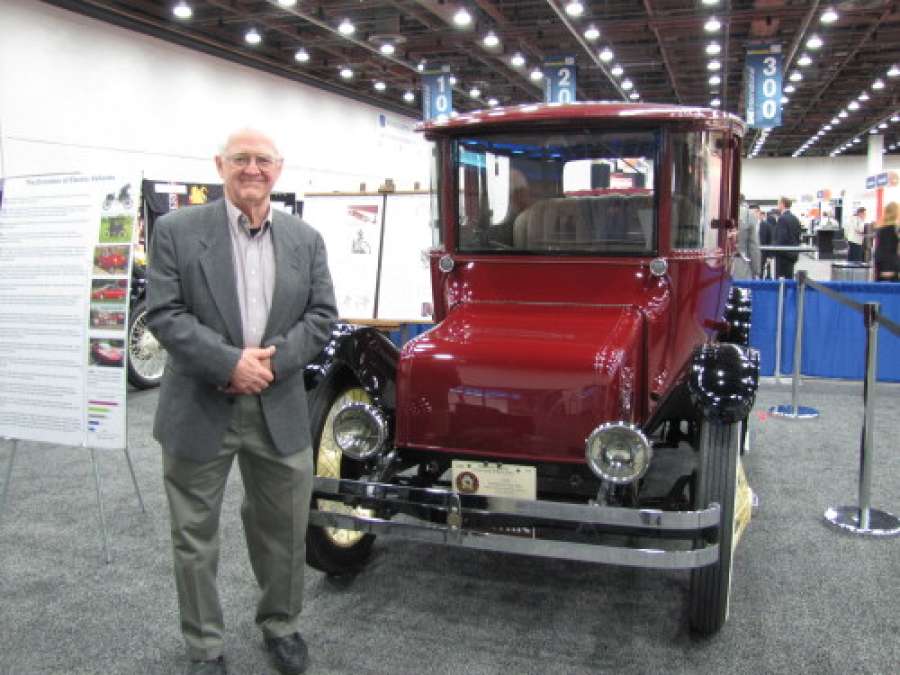Before I even entered the main gateway on the floor of the SAE World Congress, my eye caught this 1916 Detroit Electric, Model 60 Brougham. It is owned by Jack Beatty of Ann Arbor, who also owns a 1925 Detroit Electric.
Again, it is fitting that an electric vehicle from the early days of the automobile would make an appearance at the SAE World Congress 2012 in Detroit, because we are returning automobiles to their roots which is electric.
Now, do not take this wrong. The gasoline engine surely made the industry become acceptable and ubiquitous. However, it seems the technology for gasoline engines advanced much faster than electrification. Now, with the advent of lithium-ion batteries and other battery chemistries, the electric force is once again returning in a dramatic fashion towards driving automobiles.
Question is, just how far will we go those time with electrics? Mostly likely all the way, especially for automobiles, but not overnight simply due to cost. Hybrids seem the best compromise. With large trucks, electrification will likely take more of a hybrid role as well simply due to weight and power, especially with natural gas making headway to replace diesel fuel.
Back to the Roots of Our Future
According the handout I received from Jack Beatty, the Detroit Electric was produced between 1907 to 1939, and holds the record for the last surviving electric automobile. In addition, it is the longest lasting EV and holds the record for the total number of EVs produced.
This vehicle was first produced in Detroit by the Anderson Carriage Company, and by 1911 the company was known as the Anderson Electric Automobile company. In 1919, the company name change again to become the Detroit Electric Car company.
Early models included both a roadster style and a traditional phone booth style, noted by its high roof. By 1912, though, all the roofs were of the traditional phone booth design. Early models employed a chain drive between an electric motor positioned under the seat and a rear differential. However, by 1912, all cars employed a direct shaft between the motor and the differential.
The car sold new for $2,275 and included an aluminum body over a wood frame. Presently, the car is powered by two banks of batteries. The first bank of seven six-volt batteries is under the hood, while the second bank of seven six-volt batteries sits under the rear deck. Lower speeds are achieved at 42 volts with the banks in parallel. Higher speeds are achieved at 84 volts with the banks in series.
For the record, the company advertised the Detroit Electric as follows: “The Detroit Electric will take you anywhere that an automobile may go with a mileage radius further than you will ever care to travel in a day.”
In a company sponsored test in 1912, a Detroit Electric ran 211.3 miles on a single battery charge, though 80 miles between charges was the generally advertised figure. Jack Beatty says this car shown has a range of 60-90 miles and requires 8-16 hours to recharge.
Although originally manufactured in 1916, the car was factory updated in 1928 to conform to the specifications of the 1928 Detroit Electric 98S. Revisions included lowering the roof by four inches, now known as a chopped roof. In addition, the windshield was changed from a two piece to a one piece. Even the cowl lamps were modernized, as were the addition of bumpers.
Unfortunately, the electric cars were falling out of favor with the public. So, the Detroit Electric began to take on the appearance of a gasoline-powered auto, employing the first Willys Overland coachwork in the late 1920s and early 1930s, and later Dodge coachwork in the mid 1930s.
Special thanks to Jack Beatty for sharing this car and its wonderful history at the SAE World Congress 2012.






Comments
Very cool. At a show a few
Permalink
Very cool. At a show a few months ago, I saw an Allis-Chalmers electric tractor, though electrified farm machinery never really caught on. These very early machines in American history are cool to see.